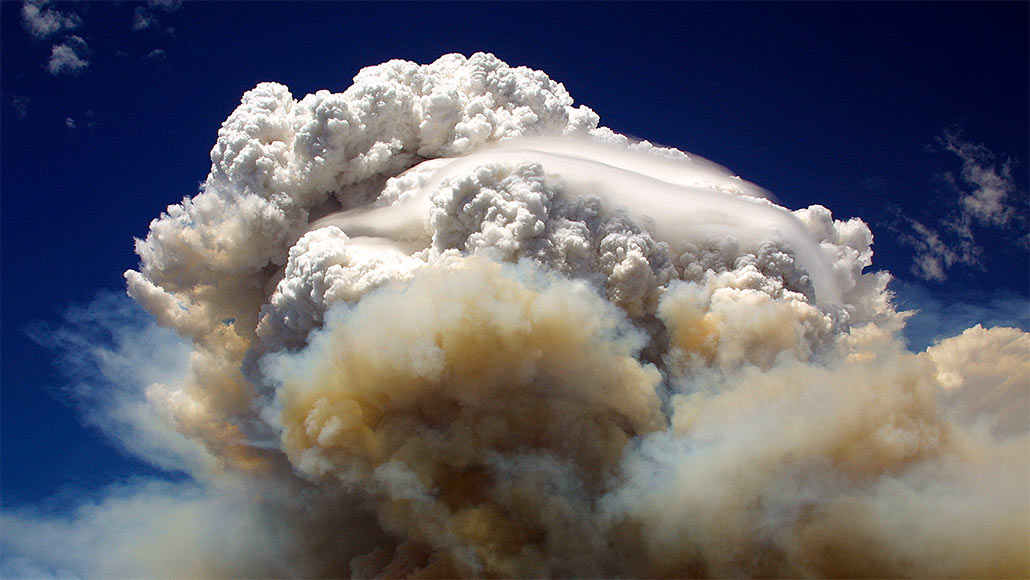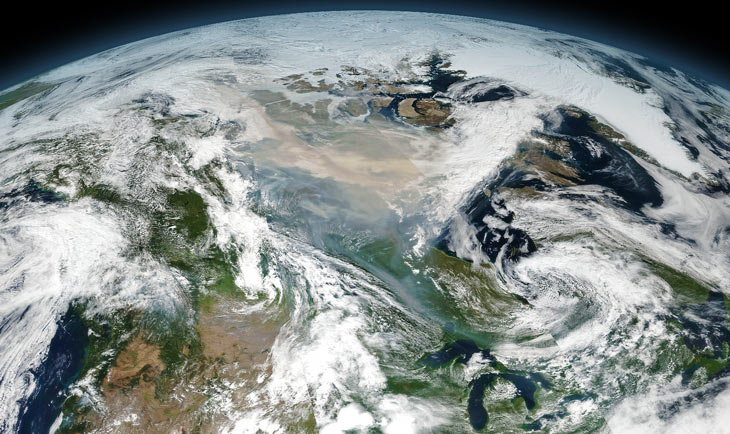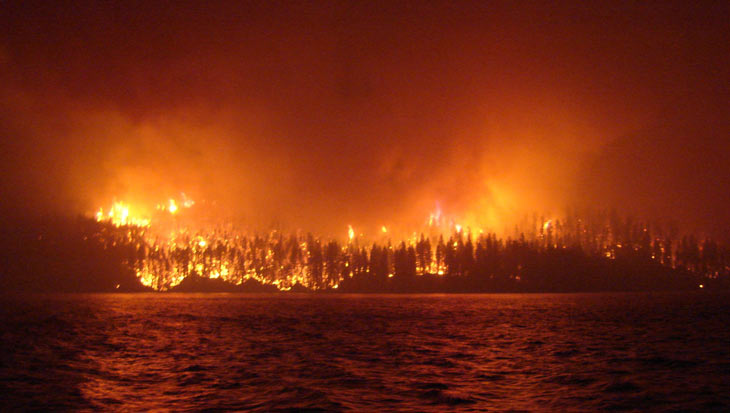
FIRE CLOUDS Pyrocumulonimbus clouds are created by intense wildfires (one from a 2004 fire in Arizona shown). The fire clouds can reach higher into the stratosphere than scientists thought, where the plumes can have climatic effects.
Eric Neitzel/Wikimedia Commons (CC BY-SA 3.0)
For the first time, scientists have seen exactly how towering clouds that rise from intense wildfires launch smoke high into the atmosphere, where it can linger for months and mess with the protective ozone layer.
Cooler air closer to Earth’s surface normally keeps smoke from rising too high. But as dozens of fires raged in western Canada and the U.S. Pacific Northwest in the summer of 2017, they created their own giant storm clouds called pyrocumulonimbus, or pyroCb, clouds. Within two months, these clouds had lofted smoke 12 to 23 kilometers up into the stratosphere, researchers report in the Aug. 9 Science. Solar radiation heating soot in the smoke helped it reach those soaring heights.
Using satellites, weather balloons and ground-based remote sensing, the team tracked the smoke over the Northern Hemisphere, measuring the levels of organics and black carbon, or soot. Smoke persisted in the stratosphere for about eight months, says Pengfei Yu, a climate scientist at Jinan University in Guangzhou, China.

Although smoke has been observed in the stratosphere before, this “mother of all pyroCbs” offered the first direct observation of a process called “self-lofting,” says coauthor Alan Robock, a climate scientist at Rutgers University in New Brunswick, N.J.
The observations confirmed what simulations had suggested would happen if large amounts of smoke were injected into the stratosphere via a nuclear war, the team says. “Nature did the experiment for us,” Robock says, confirming the “nuclear winter” scenario, in which smoke in the stratosphere from a city burning would have far-reaching and long-lasting climatic consequences, including blocking out sunlight and affecting ozone.
Understanding the fate of smoke particles at high altitude “is very important for climate research,” says Yafang Cheng, an atmospheric chemist at the Max Planck Institute for Chemistry in Mainz, Germany, whose research has shown that significant amounts of wildfire soot get into the stratosphere.
Importantly, Yu and his colleagues showed that “smoke in the stratosphere hangs around a long time,” says Loretta Mickley, an atmospheric chemist at Harvard University. The longer the smoke stays in the stratosphere, the more time that organics and soot in the smoke layer have to absorb sunlight or reflect it back into space. When major volcanic eruptions in past centuries have caused such solar reflection, she says, the dimming effect has led to crop failures and famines.
It’s unlikely that wildfires could loft enough smoke to cause a hemispheric dimming effect. But the smoke can damage the ozone layer, which protects Earth from too much harmful ultraviolet radiation from the sun, in two different ways.

Most immediately, as ozone-poor smoke rises into the stratosphere, it pushes out ozone-rich air, causing a temporary loss of ozone in that area, Yu says. Using sensitive instruments aboard the CALIPSO satellite, Yu’s team measured ozone losses up to 50 percent over parts of Canada during the 2017 fires.
In addition, chemical reactions with water vapor transported into the stratosphere by wildfire smoke that take place over time can also damage ozone. When water vapor breaks down, it releases reactive hydrogen oxide molecules called radicals that destroy ozone. “Although we can’t say the observed ozone [loss from these fires] is due to chemistry,” the risk of ozone loss occurring rises if more smoke reaches into the stratosphere, Yu says.
How significant those ozone losses may be “is a big question mark right now, but is being actively studied,” says study coauthor Michael Fromm, a meteorologist at the Naval Research Laboratory in Washington, D.C. PyroCbs occur from three to six dozen times a year globally, Fromm says. But these fire clouds range in size, with the biggest and most intense ones requiring “a perfect storm” of hot, dry, windy conditions along with clusters of very hot fires in close proximity in order to reach the stratosphere, he says.
Given that climate change is increasing fire frequency and intensity in some places like the North American West (SN: 12/22/18, p. 18), we can probably expect to see more of these fire clouds reaching the stratosphere, Fromm says. But, he cautions, “we are still on the learning curve when it comes to understanding pyroCbs.”






